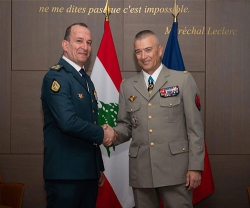Boeing B-1 Bomber Completes 10,000th Combat Mission
29.02.2012 North America
The Boeing B-1 bomber aircraft has completed its 10,000th combat mission. The heavy bomber entered service with the U.S. Air Force on June 29, 1985, and has been in nearly continuous combat for the past 10 years. The milestone mission took off from a base in Southwest Asia and was flown in support of operations over Afghanistan before returning to base.
“The B-1 brings tremendous flexibility to our nation's defense,” said Lt. Col. Alejandro Gomez, Mission Team Lead. “In any mission, the B-1 has the ability to loiter, dash, positively identify targets, show force, and strike targets precisely. Whatever our aircrews are asked to do, they can perform with this aircraft.”
B-1 crews in Southwest Asia fly a variety of missions, including close air support for troops on the ground, giving them cover and alerting them to threats they cannot see. On-site maintainers keep the fleet ready to fly.
“10,000 conventional combat missions for a relatively small fleet of 66 B-1s is a major milestone and a testament to the men and women who built, sustain and modernize the fleet, including the U.S. Air Force, Boeing and our subcontractors,” said Rick Greenwell, Boeing B-1 Program Director. “We continue to draw on expertise and experience from across Boeing to enhance our support of this amazing aircraft.”
The B-1 bomber has advanced over the years as it is modified for current needs. The aircraft began as a nuclear bomber and moved into a solely conventional role in the 1990s. It carries the largest payload in the Air Force's long-range bomber fleet -- during Operation Iraqi Freedom, it dropped 40% of all weapons while flying only 5% of the sorties.
Today's B-1 can carry a mixed load of weapons in each of its three bays. Its long range allows it to base far from the conflict and loiter unrefueled for long periods. Its swept wings allow it to fly fast, slow, low or high as the situation demands. With only four crewmembers required, missions can rapidly be adjusted in flight to keep up with adversaries. The radar and targeting pod can be used for positive target identification and the aircraft can employ a variety of other weapons, including Joint Direct Attack Munitions (JDAMs), Laser JDAMs, Joint Air-to-Surface Standoff Missiles-Extended Range, and BLU-129 warheads.
“The B-1 fleet and crews have readily adapted to an ever-changing environment to accomplish this 10,000th combat sortie milestone,” said Greenwell.
“This aircraft has proven its ability to continue to evolve and be effective well into the future,” he added.
“The B-1 brings tremendous flexibility to our nation's defense,” said Lt. Col. Alejandro Gomez, Mission Team Lead. “In any mission, the B-1 has the ability to loiter, dash, positively identify targets, show force, and strike targets precisely. Whatever our aircrews are asked to do, they can perform with this aircraft.”
B-1 crews in Southwest Asia fly a variety of missions, including close air support for troops on the ground, giving them cover and alerting them to threats they cannot see. On-site maintainers keep the fleet ready to fly.
“10,000 conventional combat missions for a relatively small fleet of 66 B-1s is a major milestone and a testament to the men and women who built, sustain and modernize the fleet, including the U.S. Air Force, Boeing and our subcontractors,” said Rick Greenwell, Boeing B-1 Program Director. “We continue to draw on expertise and experience from across Boeing to enhance our support of this amazing aircraft.”
The B-1 bomber has advanced over the years as it is modified for current needs. The aircraft began as a nuclear bomber and moved into a solely conventional role in the 1990s. It carries the largest payload in the Air Force's long-range bomber fleet -- during Operation Iraqi Freedom, it dropped 40% of all weapons while flying only 5% of the sorties.
Today's B-1 can carry a mixed load of weapons in each of its three bays. Its long range allows it to base far from the conflict and loiter unrefueled for long periods. Its swept wings allow it to fly fast, slow, low or high as the situation demands. With only four crewmembers required, missions can rapidly be adjusted in flight to keep up with adversaries. The radar and targeting pod can be used for positive target identification and the aircraft can employ a variety of other weapons, including Joint Direct Attack Munitions (JDAMs), Laser JDAMs, Joint Air-to-Surface Standoff Missiles-Extended Range, and BLU-129 warheads.
“The B-1 fleet and crews have readily adapted to an ever-changing environment to accomplish this 10,000th combat sortie milestone,” said Greenwell.
“This aircraft has proven its ability to continue to evolve and be effective well into the future,” he added.
Previous PostAustal Wins US Navy Contract for 8th & 9th JHSV
Latest news
Latest events
DefenPol China2025 - 7th Guangzhou International Defense & Police Exhibition & Summit
11 - 12 Jul 2025Nan Fung International Convention & Exhibition Center (NICEC) - ChinaIDEF 2025 Turkey - International Defence Industry Fair
22 - 27 Jul 2025Istanbul Expo Center - TurkeyDSEI 2025
09 - 12 Sep 2025Excel, London - United KingdomIntersec Saudi Arabia
30 Sep - 02 Oct 2025Riyadh International Exhibition & Convention Centre - Saudi Arabia






















